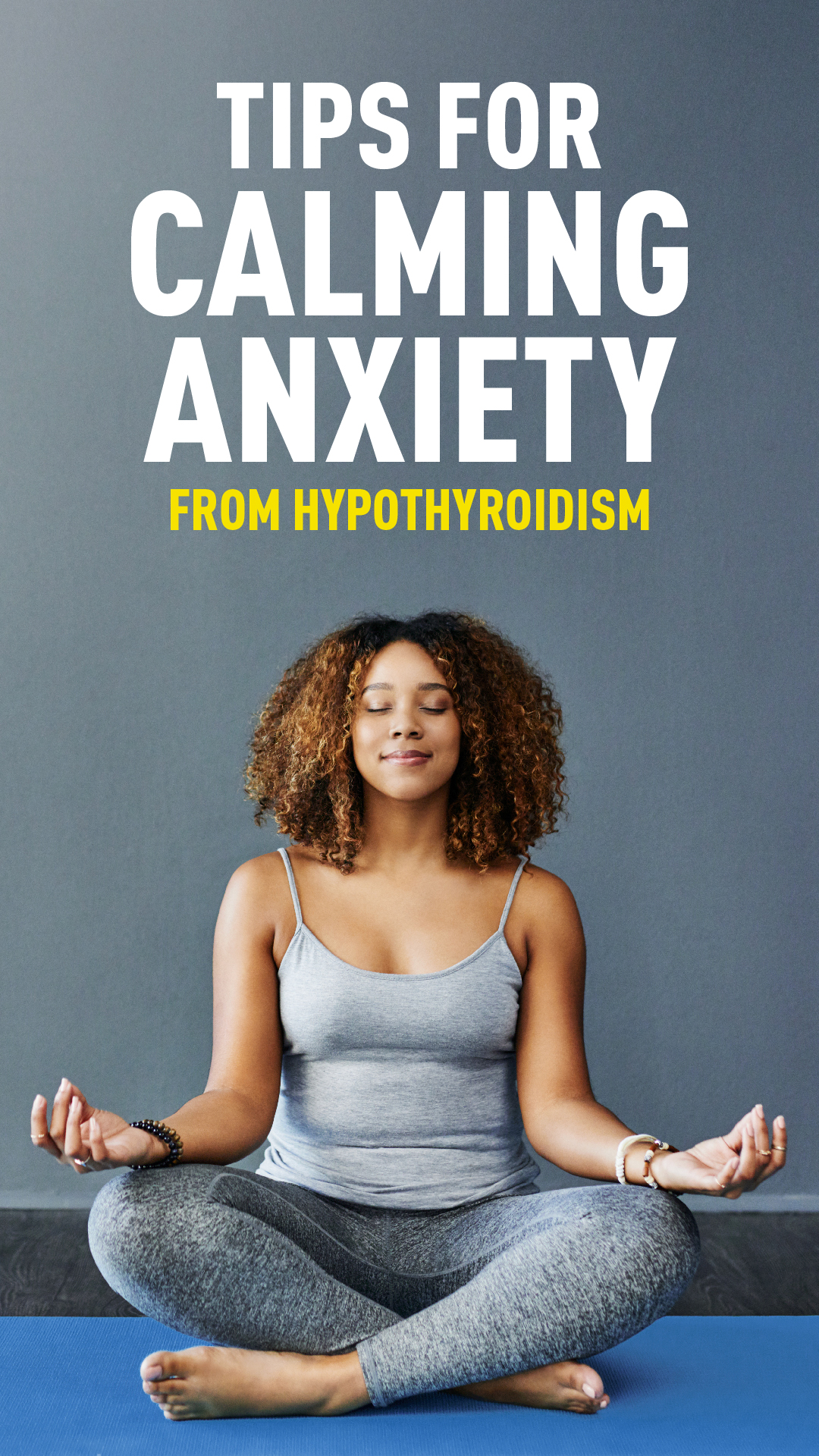Expert Advice

Acella Pharmaceuticals, LLC., is partnering with Helene Zahn-Chilberg, MA, LPMHC, LCAS-A, to bring greater awareness to the importance of thyroid care and education. This post was sponsored by Acella Pharmaceuticals and should not be construed as medical advice. Please talk to your doctor about your individual medical situation.
Disclaimer: The information provided is for educational purposes only and does not substitute professional medical advice. Consult a medical professional or healthcare provider before beginning any exercise, fitness, diet, or nutrition routine.
For those with hypothyroidism or Hashimoto’s thyroiditis some research suggests that patients may exhibit a prevalence of depression or anxiety.1 It makes sense given that the symptoms related to thyroid disease often impact patients’ every day life. The symptoms are often difficult to manage and often under-diagnosed.
This is why bolstering coping strategies to manage depression and anxiety is so important within the context of your wellness plan. When focusing on creating greater wellness in the context of managing a chronic health issue, it becomes very important to enhance measures that include your mental health. Lifestyle changes of greater mindfulness and caring for your emotional well-being can assist you in improving emotional wellness and bolster your physical health.
As I work with clients to reduce their symptoms, I encourage them to build their understanding and awareness of their bodies. Instituting a few simple strategies can make a significant difference in the intensity and frequency of the experience of depression and anxiety. Today I would like to walk you through a few exercises that can, when done with consistency, build greater body connection and form the basis for less anxiety and depression.
Coping Strategies for Anxiety and Depression
1. Pay attention to your body’s feedback. Find a quiet place for a few moments and close your eyes. Take a few deep breaths focusing on the sensation of your breath entering your lungs and abdomen and then going out again. Scan your body from your head to your toes. Where do you notice tension, pain, discomfort, relaxation or ease? What do you notice?
2. Continue to take deep breaths and let your focus remain on the flow of your breath in and out as you gain practice consciously breathing. If you get dizzy, open your eyes. If you have never done conscious deep breathing, don’t worry if it feels awkward at first; go at your own pace. Take a pause and check back in with a body scan. Do you notice any changes in the areas where you originally noticed tension, pain or discomfort? Is there any greater ease in your body? Take a moment when you finish to make notes on what you noticed, including any changes.
3. Purposefully breathe into areas where there is tension and pain. Note if you experience a shift. Start by noticing the intensity on a scale from 0 to 10, with 10 being the highest. Complete the exercise and notice when you check back if there is a shift in the intensity from when you began.
4. Actively create calm by engaging with your parasympathetic nervous system using a purposeful breathing technique. Would you be willing to practice it at least twice a day for at least three minutes? You can even do it while completing other tasks since you are just breathing.
Here is the technique:
• Breathe in and out through your nose only (no mouth breathing here). • Slowwwwwly take a breath in to the count of at least three – one- one thousand, two- one thousand, three- one thousand, pause. • Then breathe out – one- one thousand, two- one thousand, three- one thousand. • Again. Go nice and slow.
If you can go longer on the in-breath and out-breath, then do so. Please don’t forget the pause between in and out. If you get light-headed, shorten your breath. See how easy that can be? You can do this anywhere! Please practice and notice if you experience a greater and more regular state of calm.
Practice allows the mind/body system to gain comfort with and memory of the activity. This also allows you to build effectiveness in reducing overall stress and gives you a greater gauge of your body’s feedback. Here is to your health!

REFERENCE: 1. Ayhan, M.G., Uguz, F., Askin, R. and Gonen, M.S., 2014. The prevalence of depression and anxiety disorders in patients with euthyroid Hashimoto’s thyroiditis: a comparative study. General Hospital Psychiatry. 36(1), pp.95-98.
2057-v1
Note that DTE products, including NP Thyroid®, have not been reviewed by the FDA for safety or efficacy.
IMPORTANT RISK INFORMATION, INCLUDING BOXED WARNING & INDICATIONS
Important Risk Information
Drugs with thyroid hormone activity, alone or together with other therapeutic agents, have been used for the treatment of obesity. In euthyroid patients, doses within the range of daily hormonal requirements are ineffective for weight reduction. Larger doses may produce serious or even life-threatening manifestations of toxicity, particularly when given in association with sympathomimetic amines such as those used for their anorectic effects.
- NP Thyroid® is contraindicated in patients with uncorrected adrenal insufficiency, untreated thyrotoxicosis, and hypersensitivity to any component of the product.
- In the elderly and in patients with cardiovascular disease, NP Thyroid® should be used with greater caution than younger patients or those without cardiovascular disease.
- Use of NP Thyroid® in patients with diabetes mellitus or adrenal cortical insufficiency may worsen the intensity of their symptoms.
- The therapy of myxedema coma requires simultaneous administration of glucocorticoids.
- Concomitant use of NP Thyroid® with oral anticoagulants alters the sensitivity of oral anticoagulants. Prothrombin time should be closely monitored in thyroid-treated patients on oral anticoagulants.
- In infants, excessive doses of NP Thyroid® may produce craniosynostosis.
- Partial loss of hair may be experienced by children in the first few months of therapy but is usually transient.
- Adverse reactions associated with NP Thyroid® therapy are primarily those of hyperthyroidism due to therapeutic overdosage.
- Many drugs and some laboratory tests may alter the therapeutic response to NP Thyroid ®. In addition, thyroid hormones and thyroid status have varied effects on the pharmacokinetics and actions of other drugs. Administer at least 4 hours before or after drugs that are known to interfere with absorption. Evaluate the need for dose adjustments when regularly administering within one hour of certain foods that may affect absorption.
- NP Thyroid® should not be discontinued during pregnancy, and hypothyroidism diagnosed during pregnancy should be promptly treated.
Indications
NP Thyroid® (thyroid tablets, USP) is a prescription medicine that is used to treat a condition called hypothyroidism from any cause, except for cases of temporary hypothyroidism, which is usually associated with an inflammation of the thyroid (thyroiditis). It is meant to replace or supplement a hormone that is usually made by your thyroid gland.
NP Thyroid® is also used in the treatment and prevention of normal functioning thyroid goiters, such as thyroid nodules, Hashimoto’s thyroiditis, multinodular goiter, and in the management of thyroid cancer.
Revised
10/2023
You Are About To Leave This Website
By clicking continue, this link will take you to a website to which Alora Pharmaceuticals’ Policies & Terms of Use do not apply.
^Based on prescriptions filled, NP Thyroid® is the #1 Prescribed DTE in the United States. Source: IQVIA National Prescription Audit (NPA) data on file. Acella Pharmaceuticals, LLC.
